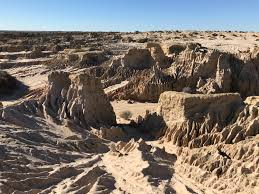(单词翻译:单击)
As it turned out, there would be a great deal else to be puzzled about, and one of the most puzzling findings of all would come from Thorne's own part of the world, in the outback of Australia. In 1968, a geologist named Jim Bowler was poking around on a long-dried lakebed called Mungo in a parched and lonely corner of western New South Wales when something very unexpected caught his eye. Sticking out of a crescent-shaped sand ridge of a type known as a lunette were some human bones. At the time, it was believed that humans had been in Australia for no more than 8,000 years, but Mungo had been dry for 12,000 years. So what was anyone doing in such an inhospitable place?
后来的发现证实,别的令人费解的事情还有很多,其中最令人赞解的发现之一来自澳大利亚内陆地区,艾伦·桑恩的家乡。1968年,一个名为吉姆·鲍勒的地质学家来到新南威尔士州一个荒无人烟的地方,在一个名为蒙戈的干涸已久的湖底搜寻,突然,某种意想不到的东西出现在他的视线中。在月牙状的沙脊中,突现一块人类的化石。当时人们认为,人类存在于澳大利亚不会超过8000年,但是蒙戈湖已经干涸了大约12000年,什么人会到这么一个荒凉的地方呢?

The answer, provided by carbon dating, was that the bones' owner had lived there when Lake Mungo was a much more agreeable habitat, a dozen miles long, full of water and fish, fringed by pleasant groves of casuarina trees. To everyone's astonishment, the bones turned out to be 23,000 years old. Other bones found nearby were dated to as much as 60,000 years. This was unexpected to the point of seeming practically impossible. At no time since hominids first arose on Earth has Australia not been an island. Any human beings who arrived there must have come by sea, in large enough numbers to start a breeding population, after crossing sixty miles or more of open water without having any way of knowing that a convenient landfall awaited them. Having landed, the Mungo people had then found their way more than two thousand miles inland from Australia's north coast—the presumed point of entry—which suggests, according to a report in the Proceedings of the National Academy of Sciences, "that people may have first arrived substantially earlier than 60,000 years ago."
放射性碳年代测定法结果表明,在这块化石骨头的主人生活的时期,蒙戈湖还非常适宜于人类居住,湖面有20公里长,湖水满满的,里面有不少鱼,四周都是一簇簇的木麻黄树,令所有人吃惊的是,那块化石距今竟然有2.3万年。在其附近发现的别的化石,甚至达6万年之久。这太出人意料,似乎是完全不可能的。自从人科动物第一次在地球上出现以来,澳大利亚就一直是一块孤立的陆地。任何人来到这里必须走海路,而且必须有相当的数量才能繁衍生息下来,因为他们先要越过100公里宽的水域,根本不知道他们前面就有一片陆地。从澳大利亚北部海岸——这里可能是他们的登陆点——上岸以后,这些蒙戈人接着又向内陆前行了3000多公里来到内地。澳大利亚国家科学协会会议记录中的一份报告说,这表明“人类第一次到达的时间远远早于6万年以前”。


